Flink重点难点:维表关联理论和Join实战
点击上方蓝色字体,选择“设为星标”
回复”面试“获取更多惊喜

在阅读本文之前,你应该阅读过的系列:
Flink官方文档中公开的信息
1 Join 的概念
在阅读之前请一定要先了解:
数据流操作的另一个常见需求是对两条数据流中的事件进行联结(connect)或Join。Flink DataStream API中内置有两个可以根据时间条件对数据流进行Join的算子:基于间隔的Join和基于窗口的Join。本节我们会对它们进行介绍。
如果Flink内置的Join算子无法表达所需的Join语义,那么你可以通过CoProcessFunction、BroadcastProcessFunction或KeyedBroadcastProcessFunction实现自定义的Join逻辑。
注意,你要设计的Join算子需要具备高效的状态访问模式及有效的状态清理策略。
1.1 基于间隔的Join
基于间隔的Join会对两条流中拥有相同键值以及彼此之间时间戳不超过某一指定间隔的事件进行Join。
下图展示了两条流(A和B)上基于间隔的Join,如果B中事件的时间戳相较于A中事件的时间戳不早于1小时且不晚于15分钟,则会将两个事件Join起来。Join间隔具有对称性,因此上面的条件也可以表示为A中事件的时间戳相较B中事件的时间戳不早于15分钟且不晚于1小时。

基于间隔的Join目前只支持事件时间以及INNER JOIN语义(无法发出未匹配成功的事件)。下面的例子定义了一个基于间隔的Join。
input1
.intervalJoin(input2)
.between(<lower-bound>, <upper-bound>) // 相对于input1的上下界
.process(ProcessJoinFunction) // 处理匹配的事件对
Join成功的事件对会发送给ProcessJoinFunction。下界和上界分别由负时间间隔和正时间间隔来定义,例如between(Time.hour(-1), Time.minute(15))。在满足下界值小于上界值的前提下,你可以任意对它们赋值。例如,允许出现B中事件的时间戳相较A中事件的时间戳早1~2小时这样的条件。
基于间隔的Join需要同时对双流的记录进行缓冲。对第一个输入而言,所有时间戳大于当前水位线减去间隔上界的数据都会被缓冲起来;对第二个输入而言,所有时间戳大于当前水位线加上间隔下界的数据都会被缓冲起来。注意,两侧边界值都有可能为负。上图中的Join需要存储数据流A中所有时间戳大于当前水位线减去15分钟的记录,以及数据流B中所有时间戳大于当前水位线减去1小时的记录。不难想象,如果两条流的事件时间不同步,那么Join所需的存储就会显著增加,因为水位线总是由“较慢”的那条流来决定。
案例你可以参考:《Flink重点难点:时间、窗口和流Join》
1.2 基于窗口的Join
顾名思义,基于窗口的Join需要用到Flink中的窗口机制。其原理是将两条输入流中的元素分配到公共窗口中并在窗口完成时进行Join(或Cogroup)。
下面的例子展示了如何定义基于窗口的Join。
input1.join(input2)
.where(...) // 为input1指定键值属性
.equalTo(...) // 为input2指定键值属性
.window(...) // 指定WindowAssigner
[.trigger(...)] // 选择性的指定Trigger
[.evictor(...)] // 选择性的指定Evictor
.apply(...) // 指定JoinFunction
下图展示了DataStream API中基于窗口的Join是如何工作的。
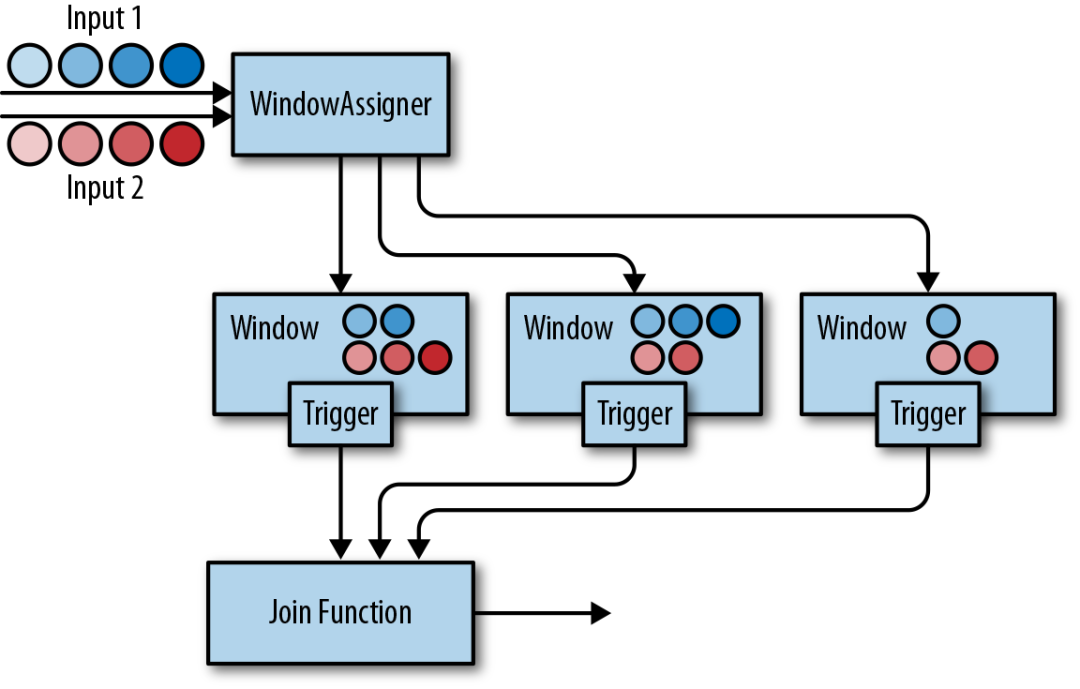
两条输入流都会根据各自的键值属性进行分区,公共窗口分配器会将二者的事件映射到公共窗口内(其中同时存储了两条流中的数据)。当窗口的计时器触发时,算子会遍历两个输入中元素的每个组合(叉乘积)去调用JoinFunction。同时你也可以自定义触发器或移除器。由于两条流中的事件会被映射到同一个窗口中,因此该过程中的触发器和移除器与常规窗口算子中的完全相同。
除了对窗口中的两条流进行Join,你还可以对它们进行Cogroup,只需将算子定义开始位置的join改为coGroup()即可。Join和Cogroup的总体逻辑相同,二者的唯一区别是:Join会为两侧输入中的每个事件对调用JoinFunction;而Cogroup中用到的CoGroupFunction会以两个输入的元素遍历器为参数,只在每个窗口中被调用一次。
注意,对划分窗口后的数据流进行Join可能会产生意想不到的语义。例如,假设你为执行Join操作的算子配置了1小时的滚动窗口,那么一旦来自两个输入的元素没有被划分到同一窗口,它们就无法Join在一起,即使二者彼此仅相差1秒钟。
案例你可以参考:《Flink重点难点:时间、窗口和流Join》
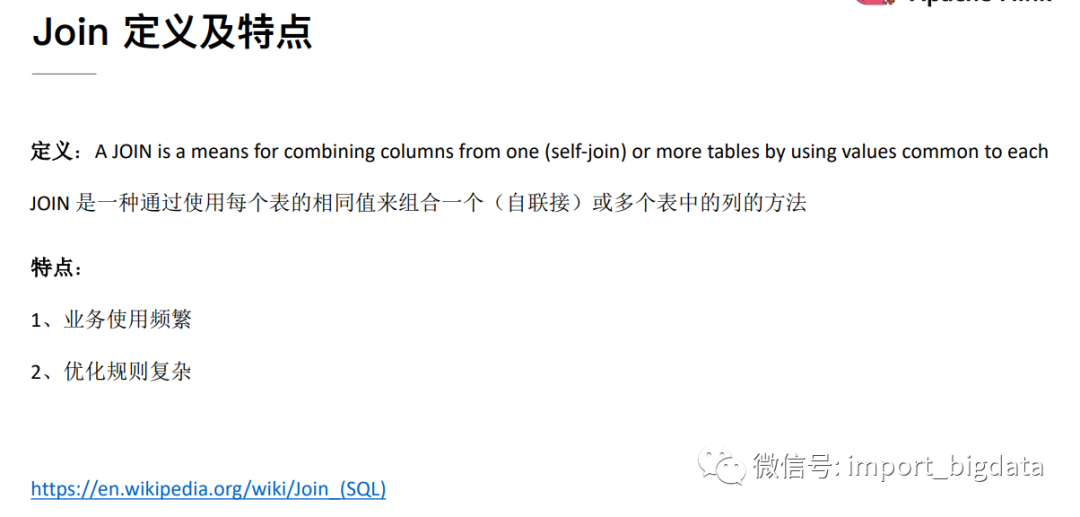
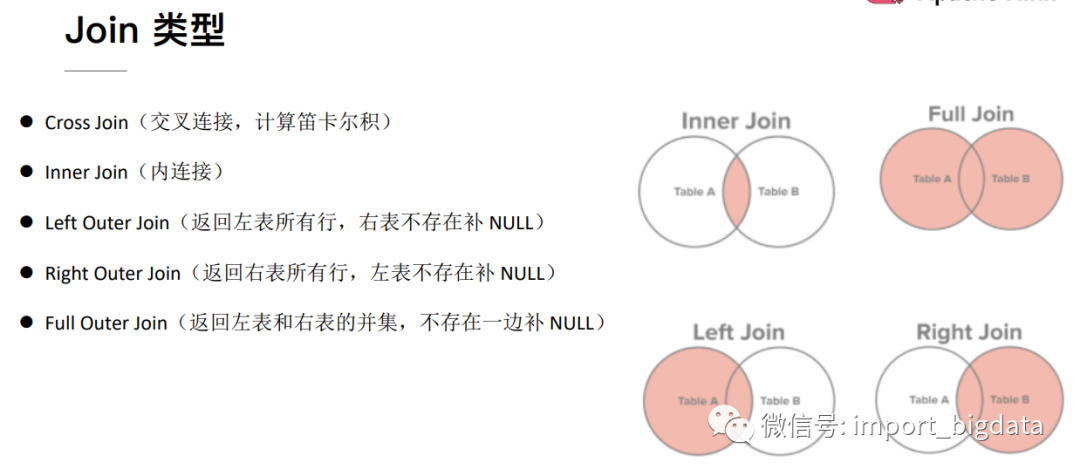
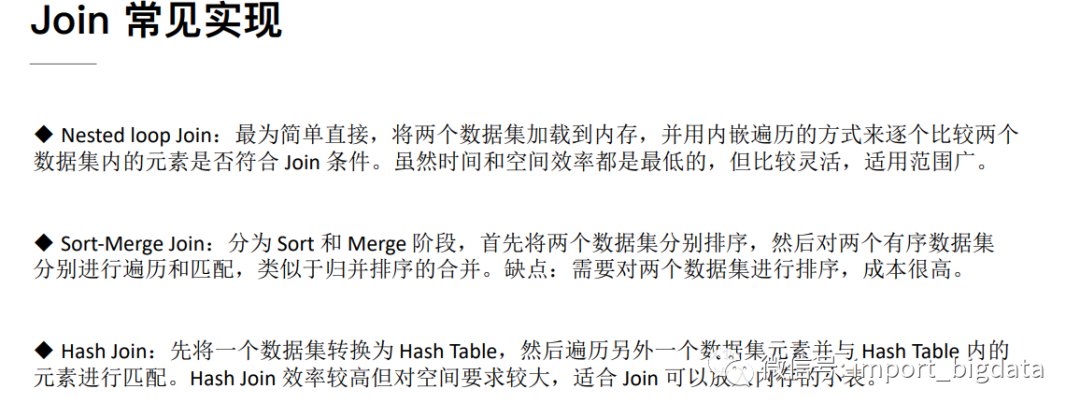
2 Streaming SQL Join
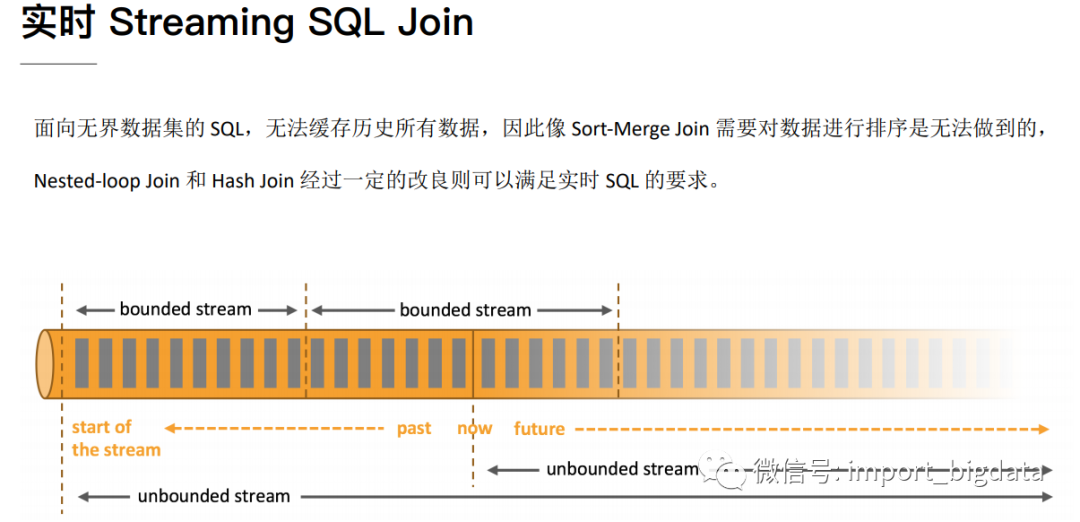
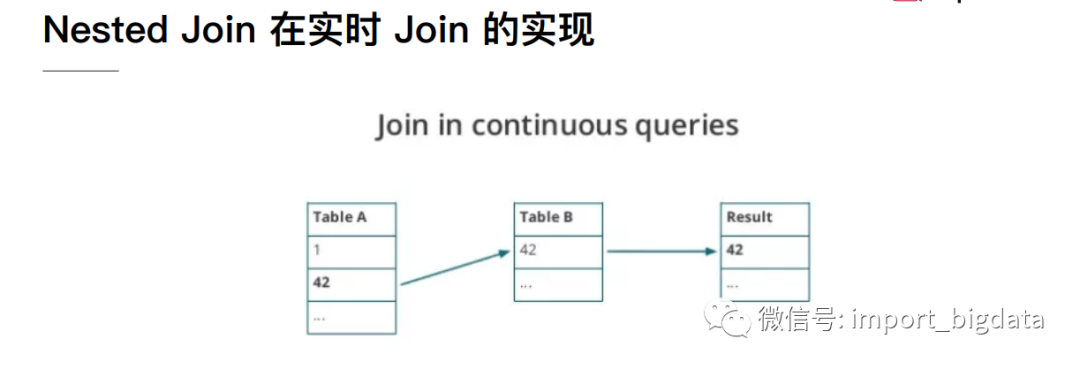
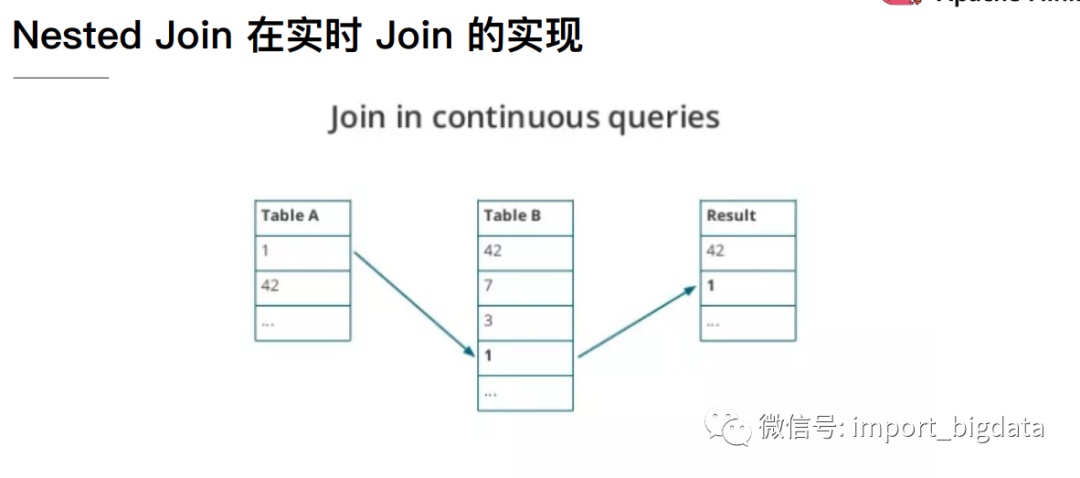
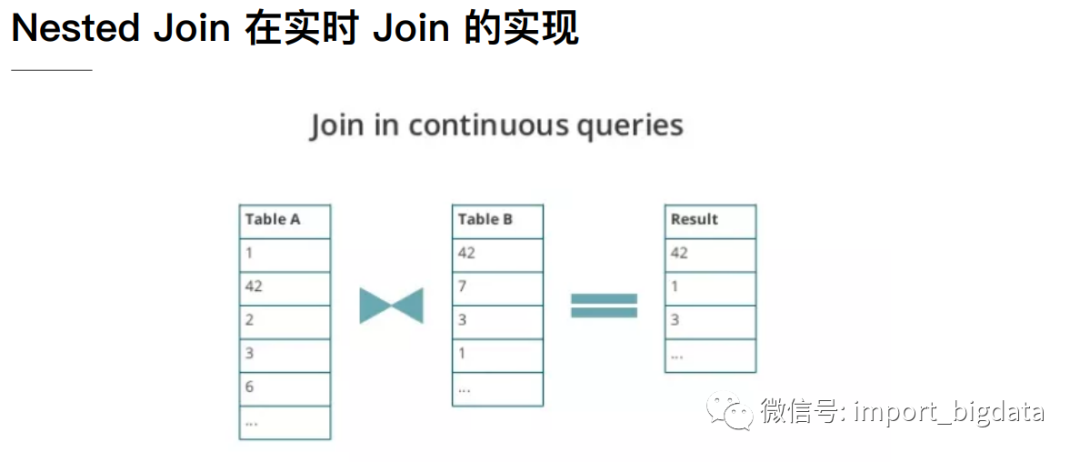

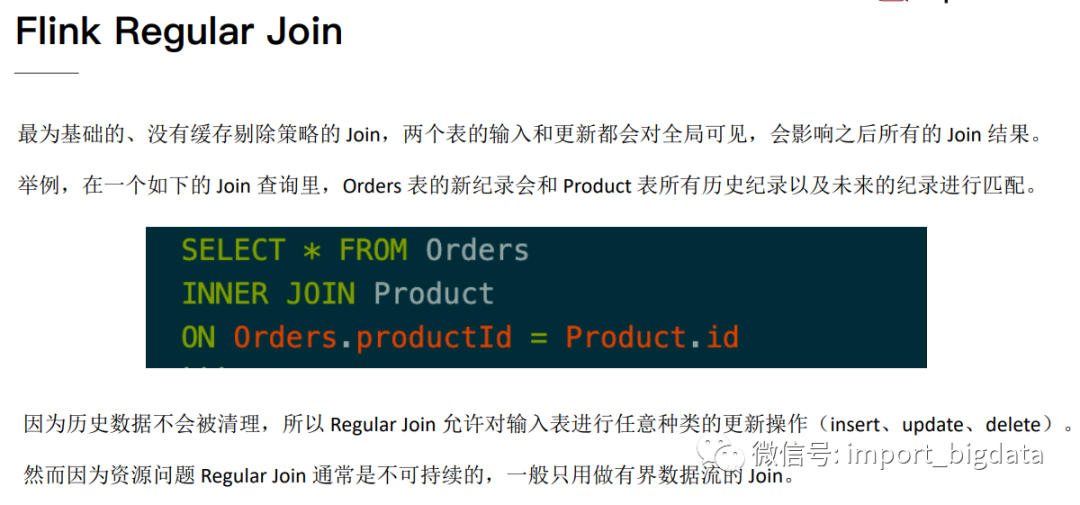
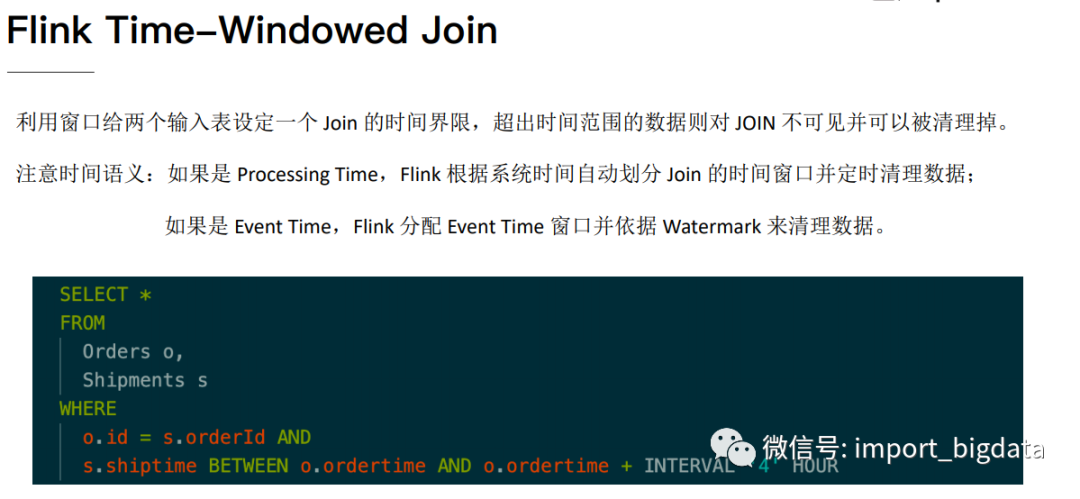
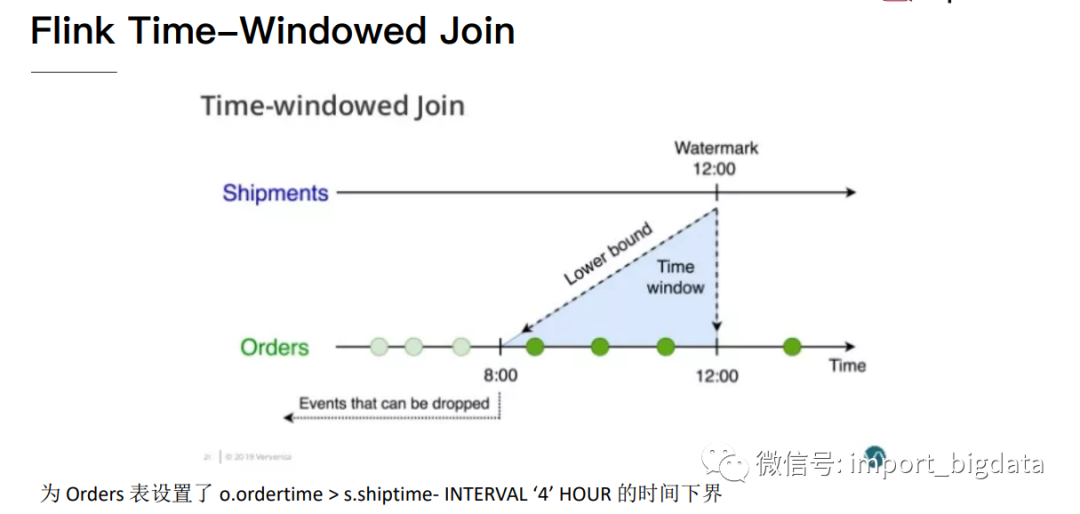
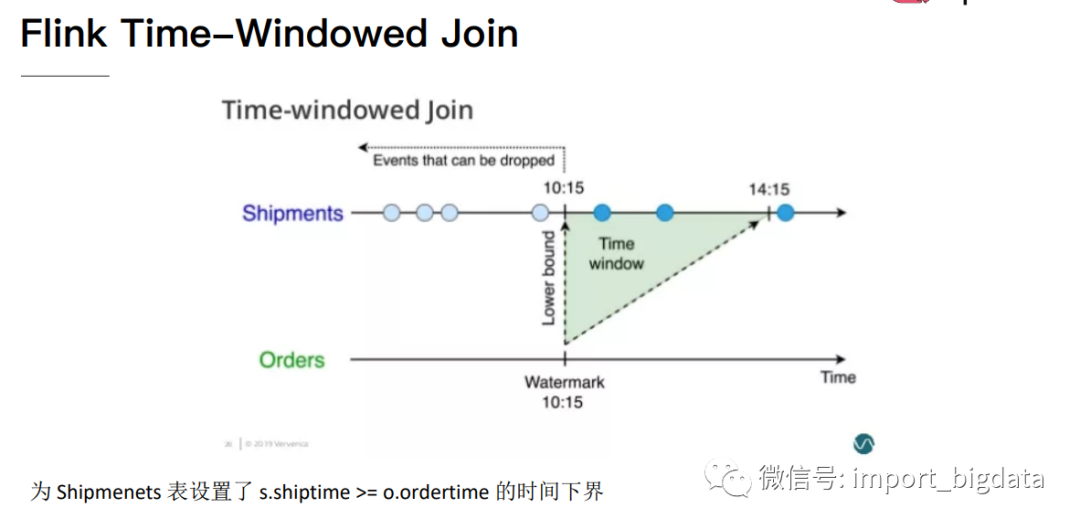

3 Flink DataStream Join
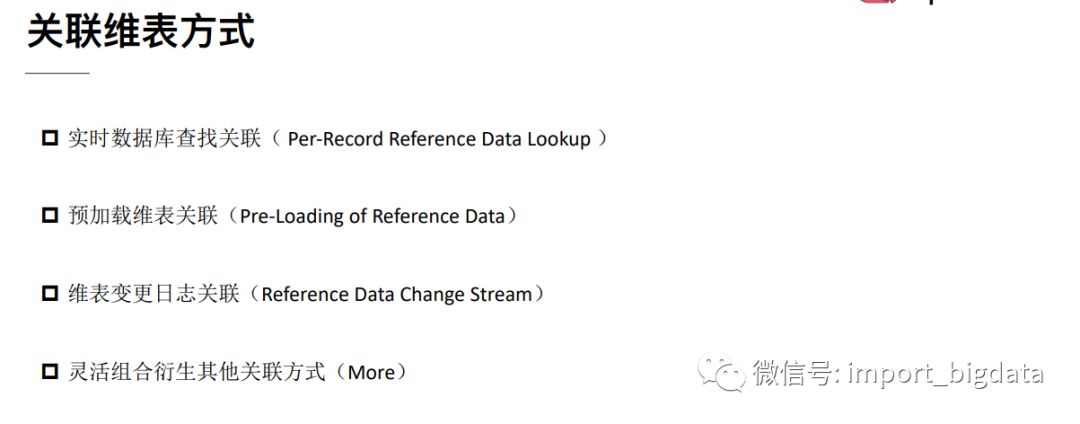

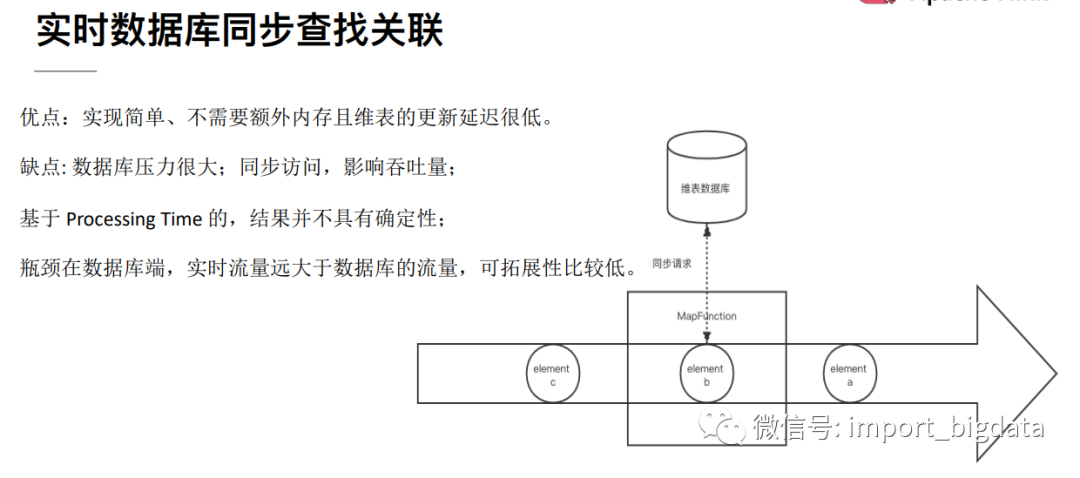
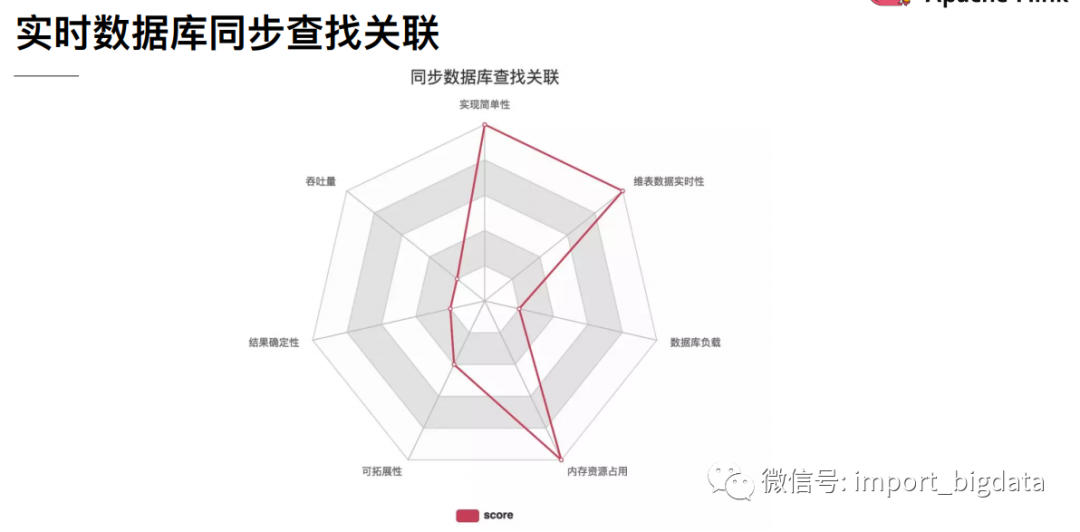
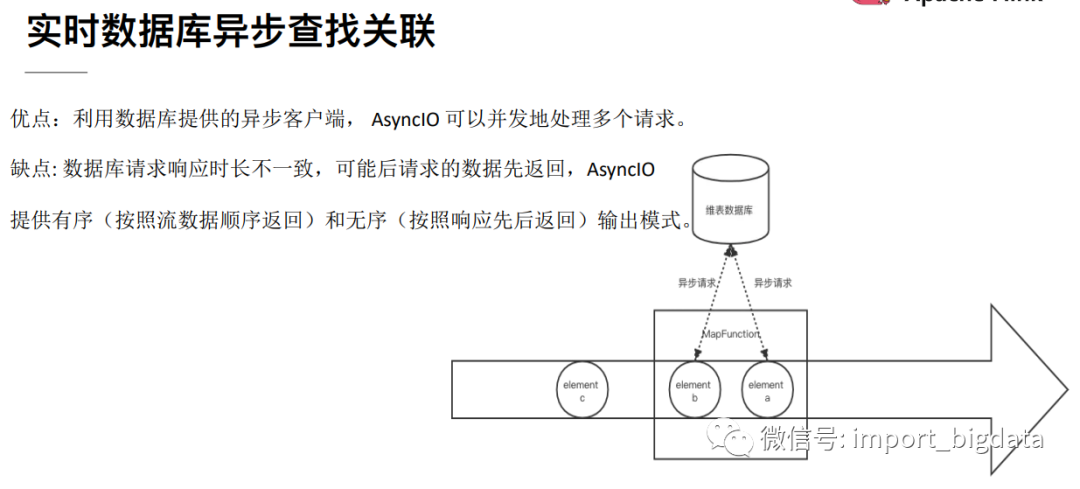
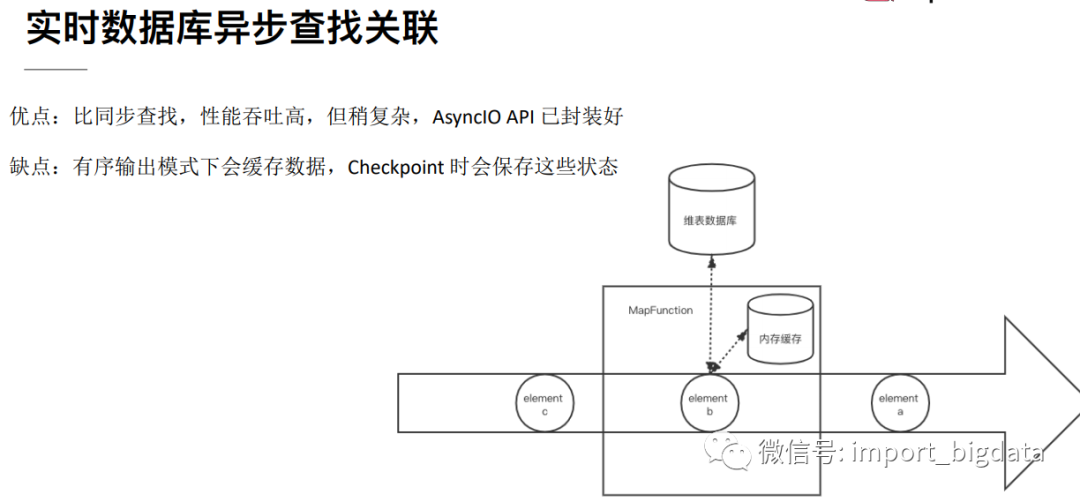
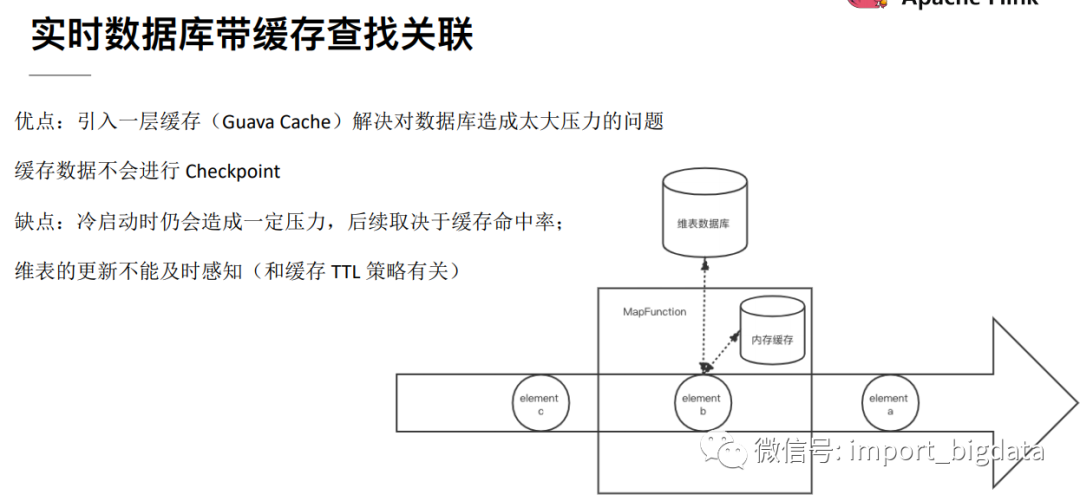
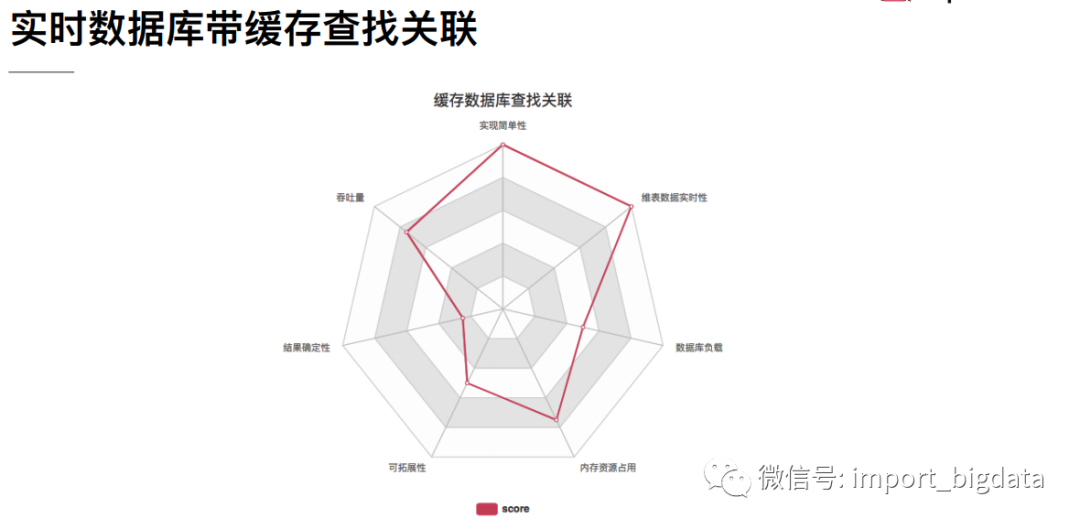
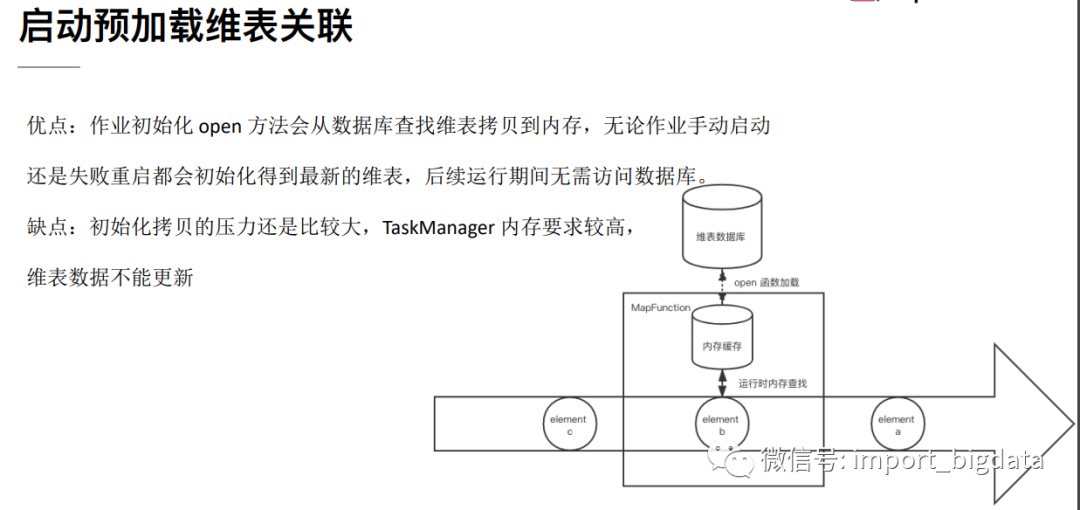
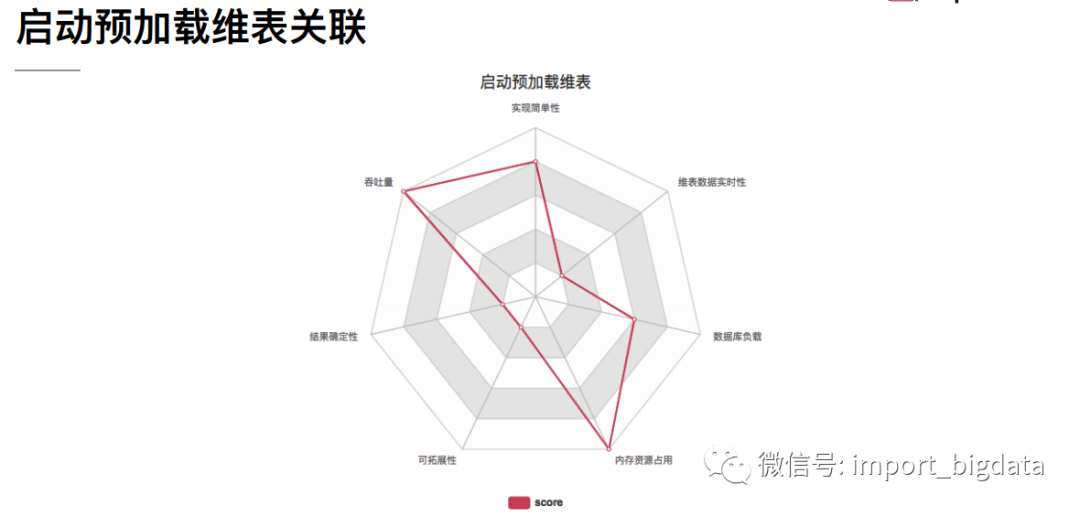
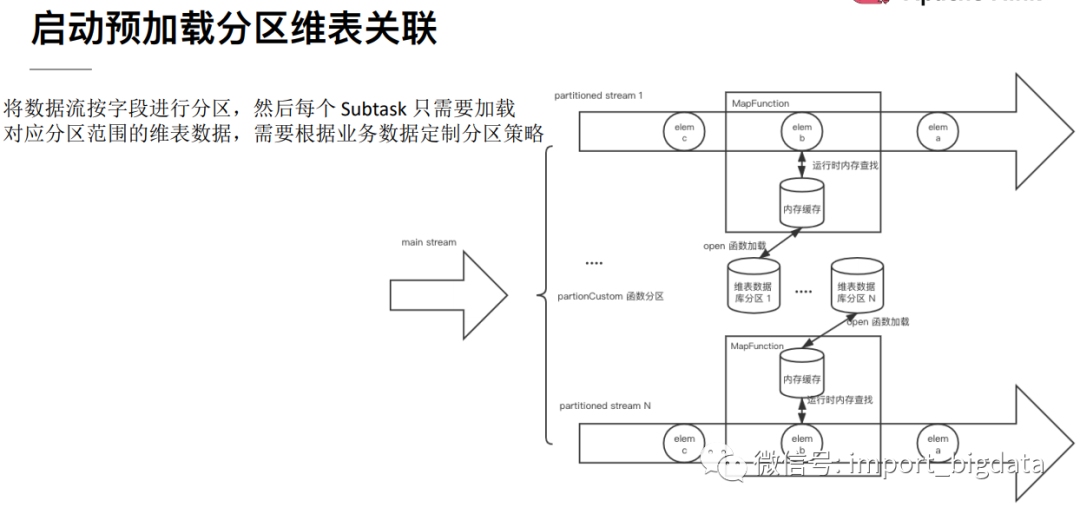
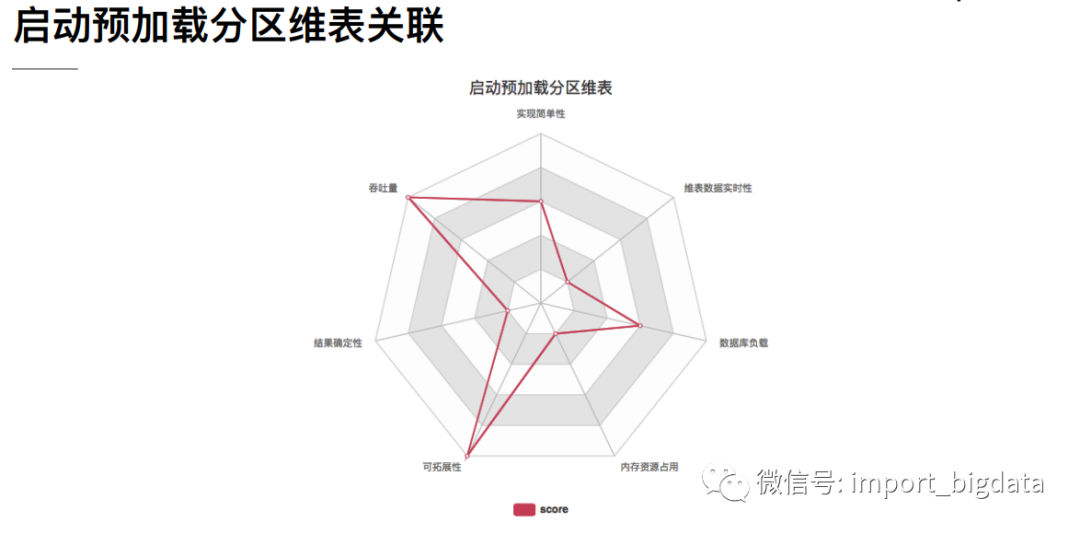
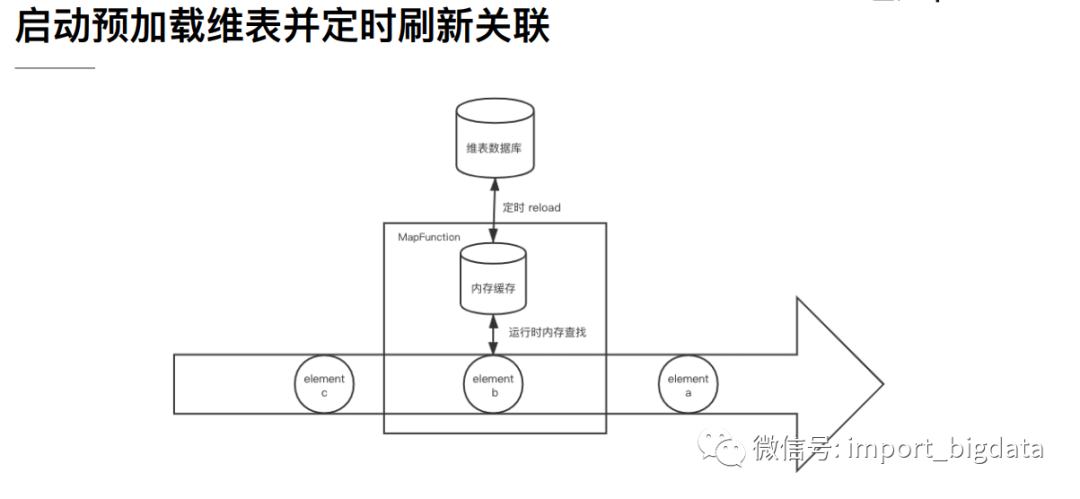
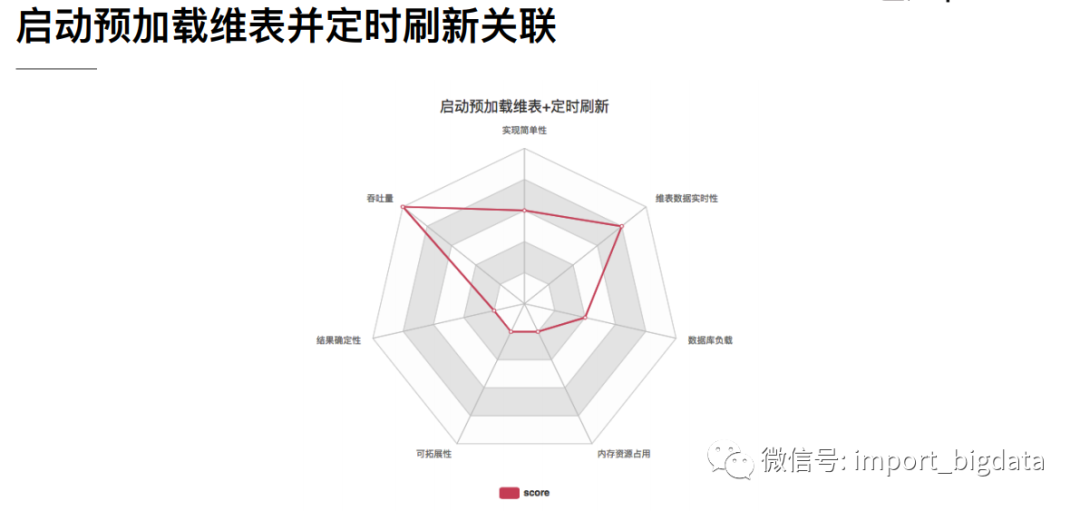
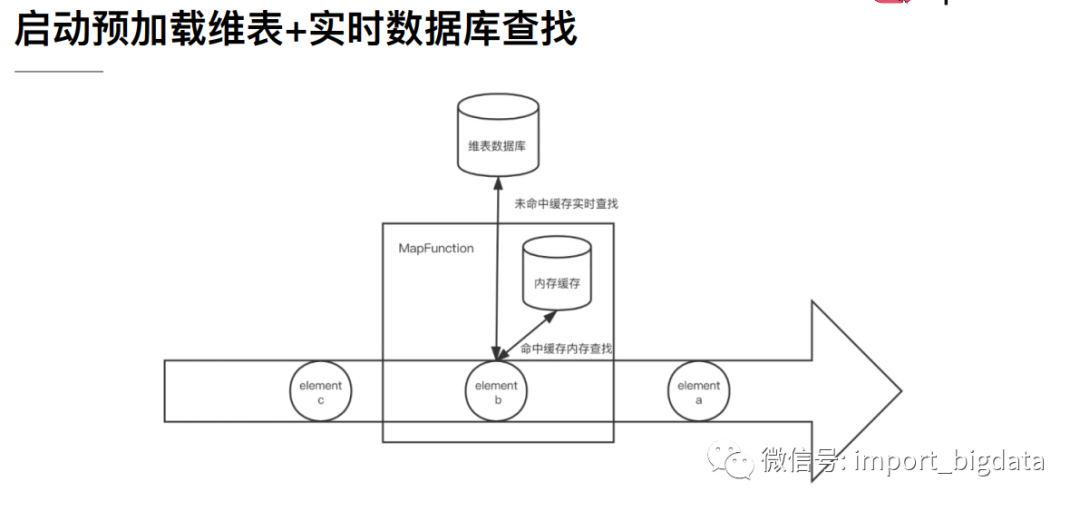


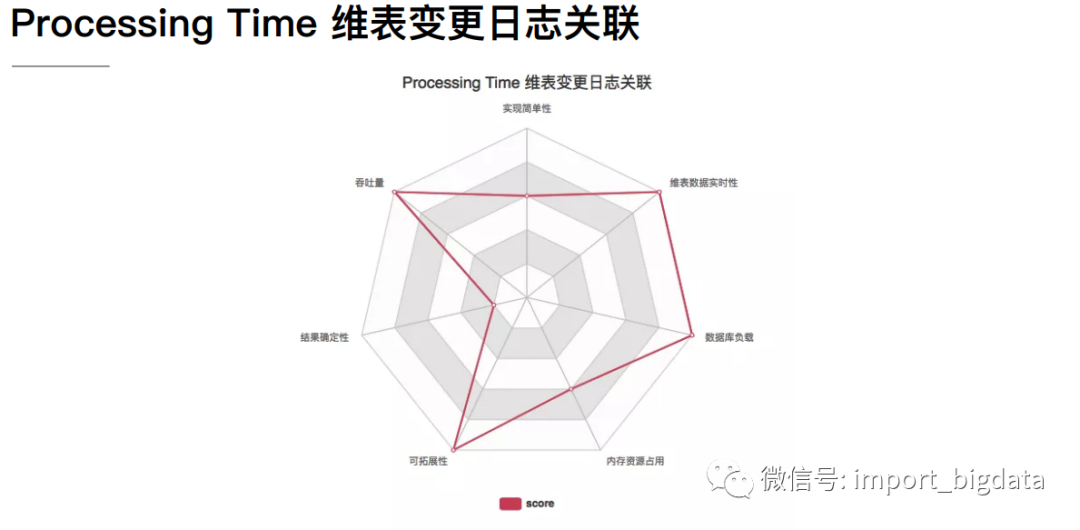
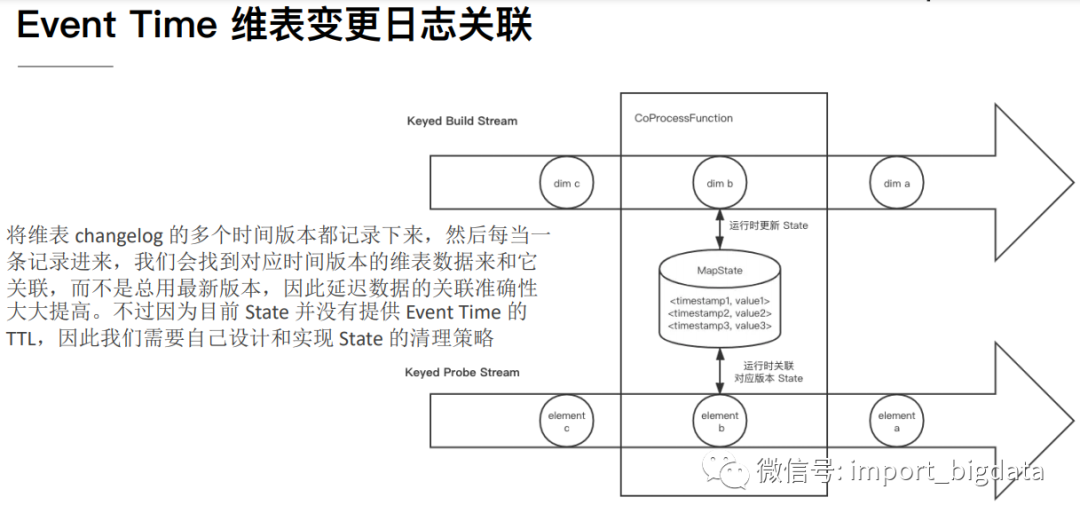
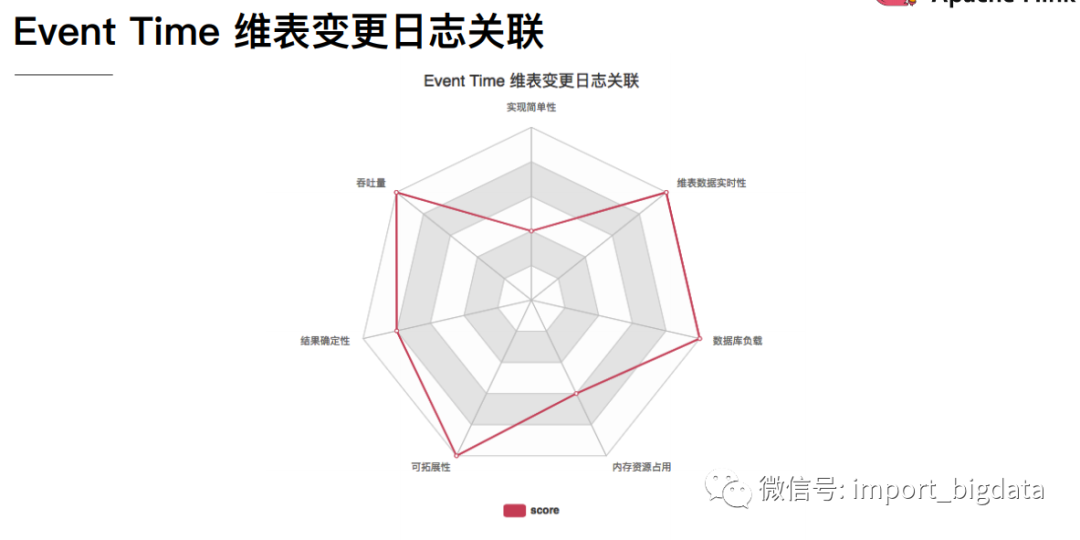
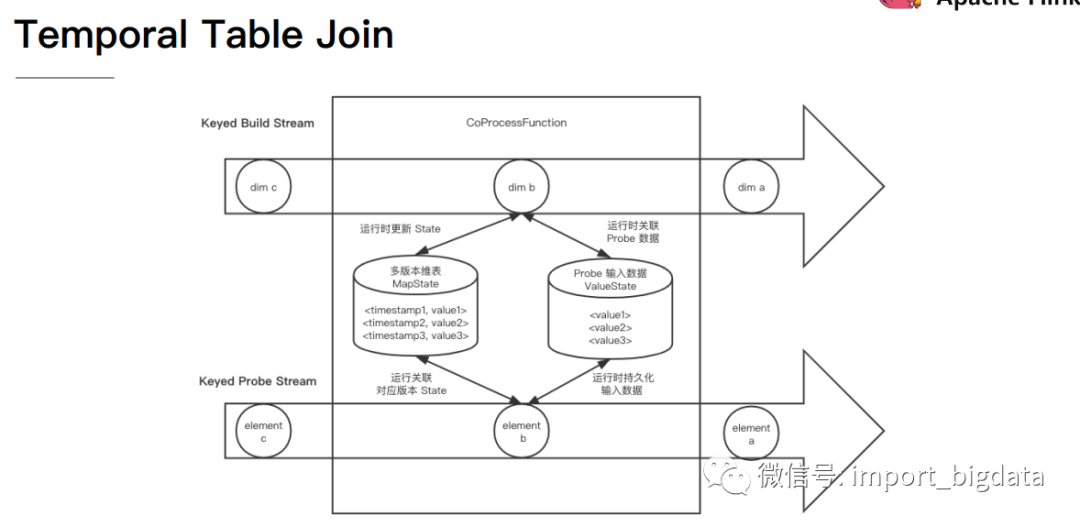
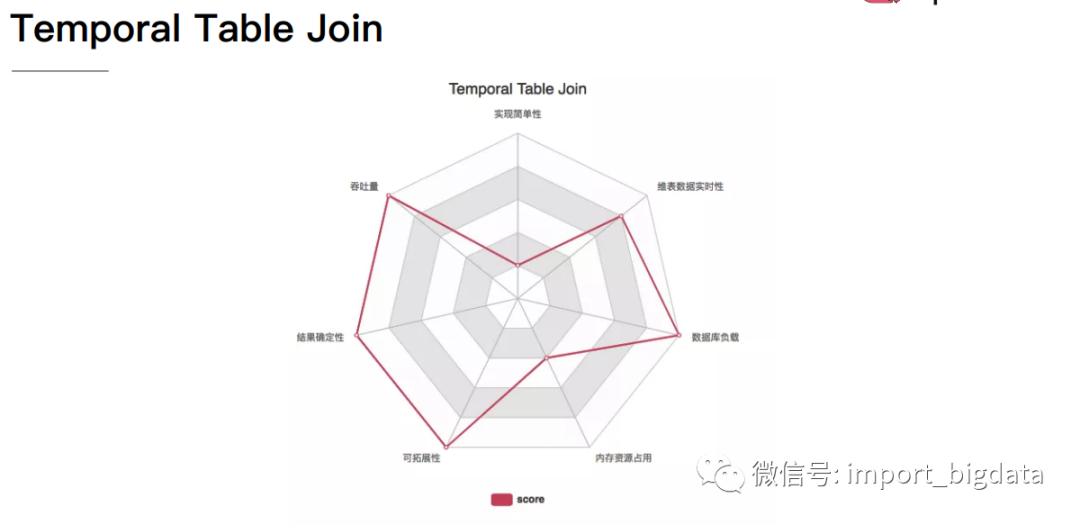
4 Flink 案例实战演练
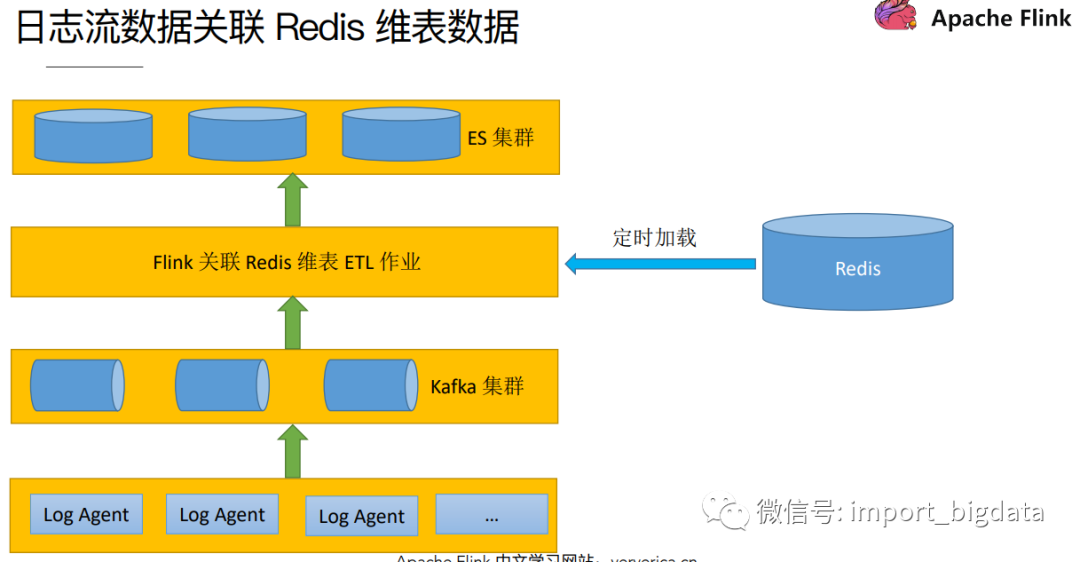
Flink维表Join实践
常见的维表Join方式有四种:
预加载维表
热存储维表
广播维表
Temporal table function join
下面分别使用这四种方式来实现一个join的需求,这个需求是:一个主流中数据是用户信息,字段包括用户姓名、城市id;维表是城市数据,字段包括城市ID、城市名称。要求用户表与城市表关联,输出为:用户名称、城市ID、城市名称。
用户表表结构如下:
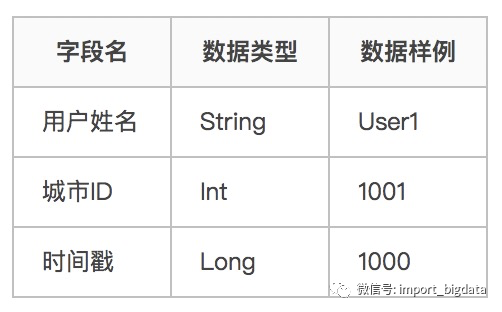
城市维表表结构如下:
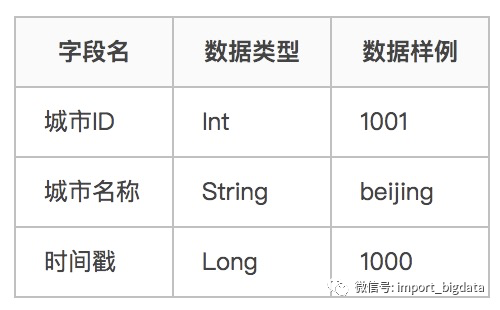
1、 预加载维表
通过定义一个类实现RichMapFunction,在open()中读取维表数据加载到内存中,在probe流map()方法中与维表数据进行关联。RichMapFunction中open方法里加载维表数据到内存的方式特点如下:
优点:实现简单. 缺点:因为数据存于内存,所以只适合小数据量并且维表数据更新频率不高的情况下。虽然可以在open中定义一个定时器定时更新维表,但是还是存在维表更新不及时的情况。下面是一个例子:
package join;
import org.apache.flink.api.common.functions.RichMapFunction;
import org.apache.flink.api.common.typeinfo.TypeHint;
import org.apache.flink.api.java.tuple.Tuple2;
import org.apache.flink.api.java.tuple.Tuple3;
import org.apache.flink.configuration.Configuration;
import org.apache.flink.streaming.api.datastream.DataStream;
import org.apache.flink.streaming.api.environment.StreamExecutionEnvironment;
import java.util.HashMap;
import java.util.Map;
/**
* 这个例子是从socket中读取的流,数据为用户名称和城市id,维表是城市id、城市名称,
* 主流和维表关联,得到用户名称、城市id、城市名称
* 这个例子采用在RichMapfunction类的open方法中将维表数据加载到内存
**/
public class JoinDemo1 {
public static void main(String[] args) throws Exception {
StreamExecutionEnvironment env = StreamExecutionEnvironment.getExecutionEnvironment();
DataStream<Tuple2<String, Integer>> textStream = env.socketTextStream("localhost", 9000, "\n")
.map(p -> {
//输入格式为:user,1000,分别是用户名称和城市编号
String[] list = p.split(",");
return new Tuple2<String, Integer>(list[0], Integer.valueOf(list[1]));
})
.returns(new TypeHint<Tuple2<String, Integer>>() {
});
DataStream<Tuple3<String, Integer, String>> result = textStream.map(new MapJoinDemo1());
result.print();
env.execute("joinDemo1");
}
static class MapJoinDemo1 extends RichMapFunction<Tuple2<String, Integer>, Tuple3<String, Integer, String>> {
//定义一个变量,用于保存维表数据在内存
Map<Integer, String> dim;
@Override
public void open(Configuration parameters) throws Exception {
//在open方法中读取维表数据,可以从数据中读取、文件中读取、接口中读取等等。
dim = new HashMap<>();
dim.put(1001, "beijing");
dim.put(1002, "shanghai");
dim.put(1003, "wuhan");
dim.put(1004, "changsha");
}
@Override
public Tuple3<String, Integer, String> map(Tuple2<String, Integer> value) throws Exception {
//在map方法中进行主流和维表的关联
String cityName = "";
if (dim.containsKey(value.f1)) {
cityName = dim.get(value.f1);
}
return new Tuple3<>(value.f0, value.f1, cityName);
}
}
}
2、 热存储维表
这种方式是将维表数据存储在Redis、HBase、MySQL等外部存储中,实时流在关联维表数据的时候实时去外部存储中查询,这种方式特点如下:
优点:维度数据量不受内存限制,可以存储很大的数据量。缺点:因为维表数据在外部存储中,读取速度受制于外部存储的读取速度;另外维表的同步也有延迟。
(1) 使用cache来减轻访问压力
可以使用缓存来存储一部分常访问的维表数据,以减少访问外部系统的次数,比如使用guava Cache。
下面是一个例子:
package join;
import com.google.common.cache.*;
import org.apache.flink.api.common.functions.RichMapFunction;
import org.apache.flink.api.common.typeinfo.TypeHint;
import org.apache.flink.api.java.tuple.Tuple2;
import org.apache.flink.api.java.tuple.Tuple3;
import org.apache.flink.configuration.Configuration;
import org.apache.flink.streaming.api.datastream.DataStream;
import org.apache.flink.streaming.api.environment.StreamExecutionEnvironment;
import java.util.HashMap;
import java.util.Map;
import java.util.concurrent.TimeUnit;
public class JoinDemo2 {
public static void main(String[] args) throws Exception {
StreamExecutionEnvironment env = StreamExecutionEnvironment.getExecutionEnvironment();
DataStream<Tuple2<String, Integer>> textStream = env.socketTextStream("localhost", 9000, "\n")
.map(p -> {
//输入格式为:user,1000,分别是用户名称和城市编号
String[] list = p.split(",");
return new Tuple2<String, Integer>(list[0], Integer.valueOf(list[1]));
})
.returns(new TypeHint<Tuple2<String, Integer>>() {
});
DataStream<Tuple3<String, Integer, String>> result = textStream.map(new MapJoinDemo1());
result.print();
env.execute("joinDemo1");
}
static class MapJoinDemo1 extends RichMapFunction<Tuple2<String, Integer>, Tuple3<String, Integer, String>> {
LoadingCache<Integer, String> dim;
@Override
public void open(Configuration parameters) throws Exception {
//使用google LoadingCache来进行缓存
dim = CacheBuilder.newBuilder()
//最多缓存个数,超过了就根据最近最少使用算法来移除缓存
.maximumSize(1000)
//在更新后的指定时间后就回收
.expireAfterWrite(10, TimeUnit.MINUTES)
//指定移除通知
.removalListener(new RemovalListener<Integer, String>() {
@Override
public void onRemoval(RemovalNotification<Integer, String> removalNotification) {
System.out.println(removalNotification.getKey() + "被移除了,值为:" + removalNotification.getValue());
}
})
.build(
//指定加载缓存的逻辑
new CacheLoader<Integer, String>() {
@Override
public String load(Integer cityId) throws Exception {
String cityName = readFromHbase(cityId);
return cityName;
}
}
);
}
private String readFromHbase(Integer cityId) {
//读取hbase
//这里写死,模拟从hbase读取数据
Map<Integer, String> temp = new HashMap<>();
temp.put(1001, "beijing");
temp.put(1002, "shanghai");
temp.put(1003, "wuhan");
temp.put(1004, "changsha");
String cityName = "";
if (temp.containsKey(cityId)) {
cityName = temp.get(cityId);
}
return cityName;
}
@Override
public Tuple3<String, Integer, String> map(Tuple2<String, Integer> value) throws Exception {
//在map方法中进行主流和维表的关联
String cityName = "";
if (dim.get(value.f1) != null) {
cityName = dim.get(value.f1);
}
return new Tuple3<>(value.f0, value.f1, cityName);
}
}
}
Flink与外部存储系统进行读写操作的时候可以使用同步方式,也就是发送一个请求后等待外部系统响应,然后再发送第二个读写请求,这样的方式吞吐量比较低,可以用提高并行度的方式来提高吞吐量,但是并行度多了也就导致了进程数量多了,占用了大量的资源。
Flink中可以使用异步IO来读写外部系统,这要求外部系统客户端支持异步IO,不过目前很多系统都支持异步IO客户端。但是如果使用异步就要涉及到三个问题:
超时:如果查询超时那么就认为是读写失败,需要按失败处理;
并发数量:如果并发数量太多,就要触发Flink的反压机制来抑制上游的写入;
返回顺序错乱:顺序错乱了要根据实际情况来处理,Flink支持两种方式:允许乱序、保证顺序。
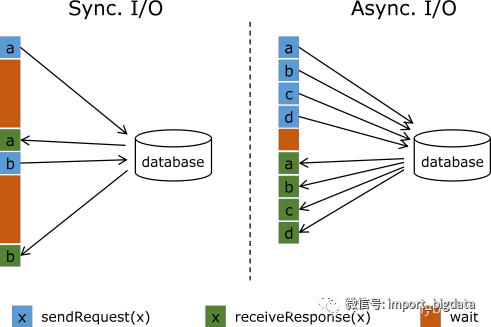
下面是一个实例,演示了试用异步IO来访问维表:
package join;
import org.apache.flink.api.common.typeinfo.TypeHint;
import org.apache.flink.api.java.tuple.Tuple2;
import org.apache.flink.api.java.tuple.Tuple3;
import org.apache.flink.configuration.Configuration;
import org.apache.flink.streaming.api.datastream.AsyncDataStream;
import org.apache.flink.streaming.api.datastream.DataStream;
import org.apache.flink.streaming.api.environment.StreamExecutionEnvironment;
import org.apache.flink.streaming.api.functions.async.ResultFuture;
import org.apache.flink.streaming.api.functions.async.RichAsyncFunction;
import java.sql.DriverManager;
import java.sql.PreparedStatement;
import java.sql.ResultSet;
import java.util.ArrayList;
import java.util.List;
import java.util.concurrent.TimeUnit;
public class JoinDemo3 {
public static void main(String[] args) throws Exception {
StreamExecutionEnvironment env = StreamExecutionEnvironment.getExecutionEnvironment();
DataStream<Tuple2<String, Integer>> textStream = env.socketTextStream("localhost", 9000, "\n")
.map(p -> {
//输入格式为:user,1000,分别是用户名称和城市编号
String[] list = p.split(",");
return new Tuple2<String, Integer>(list[0], Integer.valueOf(list[1]));
})
.returns(new TypeHint<Tuple2<String, Integer>>() {
});
DataStream<Tuple3<String,Integer, String>> orderedResult = AsyncDataStream
//保证顺序:异步返回的结果保证顺序,超时时间1秒,最大容量2,超出容量触发反压
.orderedWait(textStream, new JoinDemo3AyncFunction(), 1000L, TimeUnit.MILLISECONDS, 2)
.setParallelism(1);
DataStream<Tuple3<String,Integer, String>> unorderedResult = AsyncDataStream
//允许乱序:异步返回的结果允许乱序,超时时间1秒,最大容量2,超出容量触发反压
.unorderedWait(textStream, new JoinDemo3AyncFunction(), 1000L, TimeUnit.MILLISECONDS, 2)
.setParallelism(1);
orderedResult.print();
unorderedResult.print();
env.execute("joinDemo");
}
//定义个类,继承RichAsyncFunction,实现异步查询存储在mysql里的维表
//输入用户名、城市ID,返回 Tuple3<用户名、城市ID,城市名称>
static class JoinDemo3AyncFunction extends RichAsyncFunction<Tuple2<String, Integer>, Tuple3<String, Integer, String>> {
// 链接
private static String jdbcUrl = "jdbc:mysql://192.168.145.1:3306?useSSL=false";
private static String username = "root";
private static String password = "123";
private static String driverName = "com.mysql.jdbc.Driver";
java.sql.Connection conn;
PreparedStatement ps;
@Override
public void open(Configuration parameters) throws Exception {
super.open(parameters);
Class.forName(driverName);
conn = DriverManager.getConnection(jdbcUrl, username, password);
ps = conn.prepareStatement("select city_name from tmp.city_info where id = ?");
}
@Override
public void close() throws Exception {
super.close();
conn.close();
}
//异步查询方法
@Override
public void asyncInvoke(Tuple2<String, Integer> input, ResultFuture<Tuple3<String,Integer, String>> resultFuture) throws Exception {
// 使用 city id 查询
ps.setInt(1, input.f1);
ResultSet rs = ps.executeQuery();
String cityName = null;
if (rs.next()) {
cityName = rs.getString(1);
}
List list = new ArrayList<Tuple2<Integer, String>>();
list.add(new Tuple3<>(input.f0,input.f1, cityName));
resultFuture.complete(list);
}
//超时处理
@Override
public void timeout(Tuple2<String, Integer> input, ResultFuture<Tuple3<String,Integer, String>> resultFuture) throws Exception {
List list = new ArrayList<Tuple2<Integer, String>>();
list.add(new Tuple3<>(input.f0,input.f1, ""));
resultFuture.complete(list);
}
}
}
3、 广播维表
利用Flink的Broadcast State将维度数据流广播到下游做join操作。特点如下:
优点:维度数据变更后可以即时更新到结果中。缺点:数据保存在内存中,支持的维度数据量比较小。
下面是一个实例:
package join;
import org.apache.flink.api.common.functions.RichMapFunction;
import org.apache.flink.api.common.state.BroadcastState;
import org.apache.flink.api.common.state.MapStateDescriptor;
import org.apache.flink.api.common.state.ReadOnlyBroadcastState;
import org.apache.flink.api.common.typeinfo.TypeHint;
import org.apache.flink.api.java.tuple.Tuple2;
import org.apache.flink.api.java.tuple.Tuple3;
import org.apache.flink.configuration.Configuration;
import org.apache.flink.streaming.api.datastream.BroadcastStream;
import org.apache.flink.streaming.api.datastream.DataStream;
import org.apache.flink.streaming.api.environment.StreamExecutionEnvironment;
import org.apache.flink.streaming.api.functions.co.BroadcastProcessFunction;
import org.apache.flink.util.Collector;
import java.util.ArrayList;
import java.util.HashMap;
import java.util.List;
import java.util.Map;
/**
* 这个例子是从socket中读取的流,数据为用户名称和城市id,维表是城市id、城市名称,
* 主流和维表关联,得到用户名称、城市id、城市名称
* 这个例子采用 Flink 广播流的方式来做为维度
**/
public class JoinDemo4 {
public static void main(String[] args) throws Exception {
StreamExecutionEnvironment env = StreamExecutionEnvironment.getExecutionEnvironment();
//定义主流
DataStream<Tuple2<String, Integer>> textStream = env.socketTextStream("localhost", 9000, "\n")
.map(p -> {
//输入格式为:user,1000,分别是用户名称和城市编号
String[] list = p.split(",");
return new Tuple2<String, Integer>(list[0], Integer.valueOf(list[1]));
})
.returns(new TypeHint<Tuple2<String, Integer>>() {
});
//定义城市流
DataStream<Tuple2<Integer, String>> cityStream = env.socketTextStream("localhost", 9001, "\n")
.map(p -> {
//输入格式为:城市ID,城市名称
String[] list = p.split(",");
return new Tuple2<Integer, String>(Integer.valueOf(list[0]), list[1]);
})
.returns(new TypeHint<Tuple2<Integer, String>>() {
});
//将城市流定义为广播流
final MapStateDescriptor<Integer, String> broadcastDesc = new MapStateDescriptor("broad1", Integer.class, String.class);
BroadcastStream<Tuple2<Integer, String>> broadcastStream = cityStream.broadcast(broadcastDesc);
DataStream result = textStream.connect(broadcastStream)
.process(new BroadcastProcessFunction<Tuple2<String, Integer>, Tuple2<Integer, String>, Tuple3<String, Integer, String>>() {
//处理非广播流,关联维度
@Override
public void processElement(Tuple2<String, Integer> value, ReadOnlyContext ctx, Collector<Tuple3<String, Integer, String>> out) throws Exception {
ReadOnlyBroadcastState<Integer, String> state = ctx.getBroadcastState(broadcastDesc);
String cityName = "";
if (state.contains(value.f1)) {
cityName = state.get(value.f1);
}
out.collect(new Tuple3<>(value.f0, value.f1, cityName));
}
@Override
public void processBroadcastElement(Tuple2<Integer, String> value, Context ctx, Collector<Tuple3<String, Integer, String>> out) throws Exception {
System.out.println("收到广播数据:" + value);
ctx.getBroadcastState(broadcastDesc).put(value.f0, value.f1);
}
});
result.print();
env.execute("joinDemo");
}
}
4、 Temporal table function join
Temporal table是持续变化表上某一时刻的视图,Temporal table function是一个表函数,传递一个时间参数,返回Temporal table这一指定时刻的视图。
可以将维度数据流映射为Temporal table,主流与这个Temporal table进行关联,可以关联到某一个版本(历史上某一个时刻)的维度数据。
Temporal table function join的特点如下:
优点:维度数据量可以很大,维度数据更新及时,不依赖外部存储,可以关联不同版本的维度数据。缺点:只支持在Flink SQL API中使用。
(1) ProcessingTime的一个实例
package join;
import org.apache.flink.api.common.typeinfo.TypeHint;
import org.apache.flink.api.java.tuple.Tuple2;
import org.apache.flink.streaming.api.datastream.DataStream;
import org.apache.flink.streaming.api.environment.StreamExecutionEnvironment;
import org.apache.flink.table.api.EnvironmentSettings;
import org.apache.flink.table.api.Table;
import org.apache.flink.table.api.java.StreamTableEnvironment;
import org.apache.flink.table.functions.TemporalTableFunction;
import org.apache.flink.types.Row;
public class JoinDemo5 {
public static void main(String[] args) throws Exception {
StreamExecutionEnvironment env = StreamExecutionEnvironment.getExecutionEnvironment();
EnvironmentSettings bsSettings = EnvironmentSettings.newInstance().useBlinkPlanner().inStreamingMode().build();
StreamTableEnvironment tableEnv = StreamTableEnvironment.create(env, bsSettings);
//定义主流
DataStream<Tuple2<String, Integer>> textStream = env.socketTextStream("localhost", 9000, "\n")
.map(p -> {
//输入格式为:user,1000,分别是用户名称和城市编号
String[] list = p.split(",");
return new Tuple2<String, Integer>(list[0], Integer.valueOf(list[1]));
})
.returns(new TypeHint<Tuple2<String, Integer>>() {
});
//定义城市流
DataStream<Tuple2<Integer, String>> cityStream = env.socketTextStream("localhost", 9001, "\n")
.map(p -> {
//输入格式为:城市ID,城市名称
String[] list = p.split(",");
return new Tuple2<Integer, String>(Integer.valueOf(list[0]), list[1]);
})
.returns(new TypeHint<Tuple2<Integer, String>>() {
});
//转变为Table
Table userTable = tableEnv.fromDataStream(textStream, "user_name,city_id,ps.proctime");
Table cityTable = tableEnv.fromDataStream(cityStream, "city_id,city_name,ps.proctime");
//定义一个TemporalTableFunction
TemporalTableFunction dimCity = cityTable.createTemporalTableFunction("ps", "city_id");
//注册表函数
tableEnv.registerFunction("dimCity", dimCity);
//关联查询
Table result = tableEnv
.sqlQuery("select u.user_name,u.city_id,d.city_name from " + userTable + " as u " +
", Lateral table (dimCity(u.ps)) d " +
"where u.city_id=d.city_id");
//打印输出
DataStream resultDs = tableEnv.toAppendStream(result, Row.class);
resultDs.print();
env.execute("joinDemo");
}
}
(2) EventTime的一个实例
package join;
import org.apache.flink.api.java.tuple.Tuple3;
import org.apache.flink.streaming.api.TimeCharacteristic;
import org.apache.flink.streaming.api.datastream.DataStream;
import org.apache.flink.streaming.api.environment.StreamExecutionEnvironment;
import org.apache.flink.streaming.api.functions.timestamps.BoundedOutOfOrdernessTimestampExtractor;
import org.apache.flink.streaming.api.windowing.time.Time;
import org.apache.flink.table.api.EnvironmentSettings;
import org.apache.flink.table.api.Table;
import org.apache.flink.table.api.java.StreamTableEnvironment;
import org.apache.flink.table.functions.TemporalTableFunction;
import org.apache.flink.types.Row;
import java.sql.Timestamp;
import java.util.ArrayList;
import java.util.List;
public class JoinDemo9 {
public static void main(String[] args) throws Exception {
StreamExecutionEnvironment env = StreamExecutionEnvironment.getExecutionEnvironment();
//指定是EventTime
env.setStreamTimeCharacteristic(TimeCharacteristic.EventTime);
EnvironmentSettings bsSettings = EnvironmentSettings.newInstance().useBlinkPlanner().inStreamingMode().build();
StreamTableEnvironment tableEnv = StreamTableEnvironment.create(env, bsSettings);
env.setParallelism(1);
//主流,用户流, 格式为:user_name、city_id、ts
List<Tuple3<String, Integer, Long>> list1 = new ArrayList<>();
list1.add(new Tuple3<>("user1", 1001, 1L));
list1.add(new Tuple3<>("user1", 1001, 10L));
list1.add(new Tuple3<>("user2", 1002, 2L));
list1.add(new Tuple3<>("user2", 1002, 15L));
DataStream<Tuple3<String, Integer, Long>> textStream = env.fromCollection(list1)
.assignTimestampsAndWatermarks(
//指定水位线、时间戳
new BoundedOutOfOrdernessTimestampExtractor<Tuple3<String, Integer, Long>>(Time.seconds(10)) {
@Override
public long extractTimestamp(Tuple3<String, Integer, Long> element) {
return element.f2;
}
}
);
//定义城市流,格式为:city_id、city_name、ts
List<Tuple3<Integer, String, Long>> list2 = new ArrayList<>();
list2.add(new Tuple3<>(1001, "beijing", 1L));
list2.add(new Tuple3<>(1001, "beijing2", 10L));
list2.add(new Tuple3<>(1002, "shanghai", 1L));
list2.add(new Tuple3<>(1002, "shanghai2", 5L));
DataStream<Tuple3<Integer, String, Long>> cityStream = env.fromCollection(list2)
.assignTimestampsAndWatermarks(
//指定水位线、时间戳
new BoundedOutOfOrdernessTimestampExtractor<Tuple3<Integer, String, Long>>(Time.seconds(10)) {
@Override
public long extractTimestamp(Tuple3<Integer, String, Long> element) {
return element.f2;
}
});
//转变为Table
Table userTable = tableEnv.fromDataStream(textStream, "user_name,city_id,ts.rowtime");
Table cityTable = tableEnv.fromDataStream(cityStream, "city_id,city_name,ts.rowtime");
tableEnv.createTemporaryView("userTable", userTable);
tableEnv.createTemporaryView("cityTable", cityTable);
//定义一个TemporalTableFunction
TemporalTableFunction dimCity = cityTable.createTemporalTableFunction("ts", "city_id");
//注册表函数
tableEnv.registerFunction("dimCity", dimCity);
//关联查询
Table result = tableEnv
.sqlQuery("select u.user_name,u.city_id,d.city_name,u.ts from userTable as u " +
", Lateral table (dimCity(u.ts)) d " +
"where u.city_id=d.city_id");
//打印输出
DataStream resultDs = tableEnv.toAppendStream(result, Row.class);
resultDs.print();
env.execute("joinDemo");
}
}
结果输出为:
user1,1001,beijing,1970-01-01T00:00:00.001
user1,1001,beijing2,1970-01-01T00:00:00.010
user2,1002,shanghai,1970-01-01T00:00:00.002
user2,1002,shanghai2,1970-01-01T00:00:00.015
通过结果可以看到,根据主流中的EventTime的时间,去维表流中取响应时间版本的数据。
(3) Kafka Source的EventTime实例
package join.temporaltablefunctionjoin;
import lombok.Data;
import org.apache.flink.streaming.api.TimeCharacteristic;
import org.apache.flink.streaming.api.datastream.DataStream;
import org.apache.flink.streaming.api.environment.StreamExecutionEnvironment;
import org.apache.flink.streaming.api.functions.timestamps.BoundedOutOfOrdernessTimestampExtractor;
import org.apache.flink.streaming.api.windowing.time.Time;
import org.apache.flink.streaming.connectors.kafka.FlinkKafkaConsumer;
import org.apache.flink.table.api.EnvironmentSettings;
import org.apache.flink.table.api.Table;
import org.apache.flink.table.api.java.StreamTableEnvironment;
import org.apache.flink.table.functions.TemporalTableFunction;
import org.apache.flink.types.Row;
import java.io.Serializable;
import java.util.Properties;
public class JoinDemo10 {
public static void main(String[] args) throws Exception {
StreamExecutionEnvironment env = StreamExecutionEnvironment.getExecutionEnvironment();
//指定是EventTime
env.setStreamTimeCharacteristic(TimeCharacteristic.EventTime);
EnvironmentSettings bsSettings = EnvironmentSettings.newInstance().useBlinkPlanner().inStreamingMode().build();
StreamTableEnvironment tableEnv = StreamTableEnvironment.create(env, bsSettings);
env.setParallelism(1);
//Kafka的ip和要消费的topic,//Kafka设置
String kafkaIPs = "192.168.***.**1:9092,192.168.***.**2:9092,192.168.***.**3:9092";
Properties props = new Properties();
props.setProperty("bootstrap.servers", kafkaIPs);
props.setProperty("group.id", "group.cyb.2");
//读取用户信息Kafka
FlinkKafkaConsumer<UserInfo> userConsumer = new FlinkKafkaConsumer<UserInfo>("user", new UserInfoSchema(), props);
userConsumer.setStartFromEarliest();
userConsumer.assignTimestampsAndWatermarks(new BoundedOutOfOrdernessTimestampExtractor<UserInfo>(Time.seconds(0)) {
@Override
public long extractTimestamp(UserInfo userInfo) {
return userInfo.getTs();
}
});
//读取城市维度信息Kafka
FlinkKafkaConsumer<CityInfo> cityConsumer = new FlinkKafkaConsumer<CityInfo>("city", new CityInfoSchema(), props);
cityConsumer.setStartFromEarliest();
cityConsumer.assignTimestampsAndWatermarks(new BoundedOutOfOrdernessTimestampExtractor<CityInfo>(Time.seconds(0)) {
@Override
public long extractTimestamp(CityInfo cityInfo) {
return cityInfo.getTs();
}
});
//主流,用户流, 格式为:user_name、city_id、ts
Table userTable = tableEnv.fromDataStream(env.addSource(userConsumer),"userName,cityId,ts.rowtime" );
//定义城市维度流,格式为:city_id、city_name、ts
Table cityTable = tableEnv.fromDataStream(env.addSource(cityConsumer),"cityId,cityName,ts.rowtime");
tableEnv.createTemporaryView("userTable", userTable);
tableEnv.createTemporaryView("cityTable", cityTable);
//定义一个TemporalTableFunction
TemporalTableFunction dimCity = cityTable.createTemporalTableFunction("ts", "cityId");
//注册表函数
tableEnv.registerFunction("dimCity", dimCity);
Table u = tableEnv.sqlQuery("select * from userTable");
u.printSchema();
tableEnv.toAppendStream(u, Row.class).print("用户流接收到:");
Table c = tableEnv.sqlQuery("select * from cityTable");
c.printSchema();
tableEnv.toAppendStream(c, Row.class).print("城市流接收到:");
//关联查询
Table result = tableEnv
.sqlQuery("select u.userName,u.cityId,d.cityName,u.ts " +
"from userTable as u " +
", Lateral table (dimCity(u.ts)) d " +
"where u.cityId=d.cityId");
//打印输出
DataStream resultDs = tableEnv.toAppendStream(result, Row.class);
resultDs.print("\t\t关联输出:");
env.execute("joinDemo");
}
}
package join.temporaltablefunctionjoin;
import java.io.Serializable;
@Data
public class UserInfo implements Serializable {
private String userName;
private Integer cityId;
private Long ts;
}
package join.temporaltablefunctionjoin;
import java.io.Serializable;
@Data
public class CityInfo implements Serializable {
private Integer cityId;
private String cityName;
private Long ts;
}
package join.temporaltablefunctionjoin;
import com.alibaba.fastjson.JSON;
import com.alibaba.fastjson.TypeReference;
import org.apache.flink.api.common.typeinfo.TypeHint;
import org.apache.flink.api.common.typeinfo.TypeInformation;
import org.apache.flink.api.common.serialization.DeserializationSchema;
import java.io.IOException;
import java.nio.charset.StandardCharsets;
public class UserInfoSchema implements DeserializationSchema<UserInfo> {
@Override
public UserInfo deserialize(byte[] message) throws IOException {
String jsonStr = new String(message, StandardCharsets.UTF_8);
UserInfo data = JSON.parseObject(jsonStr, new TypeReference<UserInfo>() {});
return data;
}
@Override
public boolean isEndOfStream(UserInfo nextElement) {
return false;
}
@Override
public TypeInformation<UserInfo> getProducedType() {
return TypeInformation.of(new TypeHint<UserInfo>() {
});
}
}
package join.temporaltablefunctionjoin;
import com.alibaba.fastjson.JSON;
import com.alibaba.fastjson.TypeReference;
import org.apache.flink.api.common.serialization.DeserializationSchema;
import org.apache.flink.api.common.typeinfo.TypeHint;
import org.apache.flink.api.common.typeinfo.TypeInformation;
import java.io.IOException;
import java.nio.charset.StandardCharsets;
public class CityInfoSchema implements DeserializationSchema<CityInfo> {
@Override
public CityInfo deserialize(byte[] message) throws IOException {
String jsonStr = new String(message, StandardCharsets.UTF_8);
CityInfo data = JSON.parseObject(jsonStr, new TypeReference<CityInfo>() {});
return data;
}
@Override
public boolean isEndOfStream(CityInfo nextElement) {
return false;
}
@Override
public TypeInformation<CityInfo> getProducedType() {
return TypeInformation.of(new TypeHint<CityInfo>() {
});
}
}
依次向user和city两个topic中写入数据:
用户信息格式:{“userName”:“user1”,“cityId”:1,“ts”:11}
城市维度格式:{“cityId”:1,“cityName”:“nanjing”,“ts”:15}
测试得到的输出如下:
城市流接收到:> 1,beijing,1970-01-01T00:00
用户流接收到:> user1,1,1970-01-01T00:00
关联输出:> user1,1,beijing,1970-01-01T00:00
城市流接收到:> 1,shanghai,1970-01-01T00:00:00.005
用户流接收到:> user1,1,1970-01-01T00:00:00.001
关联输出:> user1,1,beijing,1970-01-01T00:00:00.001
用户流接收到:> user1,1,1970-01-01T00:00:00.004
关联输出:> user1,1,beijing,1970-01-01T00:00:00.004
用户流接收到:> user1,1,1970-01-01T00:00:00.005
关联输出:> user1,1,shanghai,1970-01-01T00:00:00.005
用户流接收到:> user1,1,1970-01-01T00:00:00.007
用户流接收到:> user1,1,1970-01-01T00:00:00.009
城市流接收到:> 1,shanghai,1970-01-01T00:00:00.007
关联输出:> user1,1,shanghai,1970-01-01T00:00:00.007
城市流接收到:> 1,wuhan,1970-01-01T00:00:00.010
关联输出:> user1,1,shanghai,1970-01-01T00:00:00.009
用户流接收到:> user1,1,1970-01-01T00:00:00.011
城市流接收到:> 1,nanjing,1970-01-01T00:00:00.015
关联输出:> user1,1,wuhan,1970-01-01T00:00:00.011
5、四种维表关联方式总结


Flink CDC我吃定了耶稣也留不住他!| Flink CDC线上问题小盘点
4万字长文 | ClickHouse基础&实践&调优全视角解析
你好,我是王知无,一个大数据领域的硬核原创作者。
做过后端架构、数据中间件、数据平台&架构、算法工程化。
专注大数据领域实时动态&技术提升&个人成长&职场进阶,欢迎关注。
